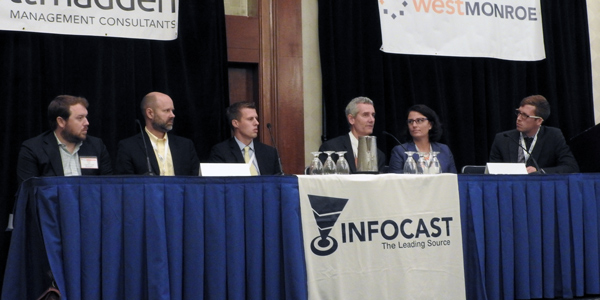By Michael Kuser
NEW YORK — While timelines for completing large power projects can be especially long in New York, developers are finding it easier to invest here now that the state is providing more predictability around clean energy procurement and market fundamentals.
That was the consensus of panelists discussing the impact of the state’s Clean Energy Standard (CES) on procurement at the Infocast New York Energy REVolution Summit held earlier this month at Times Square.
Gov. Andrew Cuomo’s Reforming the Energy Vision (REV) and its associated CES aim to meet two goals by 2030: a reduction in New York’s greenhouse gas emissions to 40% below 1990 levels and that renewables generate 50% of the state’s electricity.
To support those objectives, the governor in June announced the largest-ever state-mandated clean energy procurement, authorizing the New York State Energy Research and Development Authority (NYSERDA) and the New York Power Authority to oversee up to $1.5 billion of investment in major renewable energy projects, including offshore wind and solar.
“We’re encouraged by the number of projects, both in the interconnection queue at the ISO, and also in the pipeline of projects that are moving through Article 10,” said Doreen Harris, director of large scale renewables at NYSERDA. Article 10 is New York’s primary permitting process for authorizing the construction and operation of all utility-scale power projects 25 MW and above.
“It’s a good signal to us of the interest in New York and the supply that’s to come.”
Steady Wind
Harris said NYSERDA is focusing on three main areas around renewables: solicitation of long-term contracts; behind-the-scenes work running tracking systems and working with 152 load-serving entities; and aggressive pursuit of offshore wind.
Cuomo in January called for the development of 2,400 MW of offshore wind projects by 2030, starting with the 90-MW South Fork Project off Montauk, Long Island. (See New York Seeks to Lead US in Offshore Wind.)
“The way we are evaluating proposals is more complex than it used to be under the [renewable portfolio standard] in the sense that, first of all, we are looking to signal through some new threshold criteria the desire to really move projects through the pipeline in New York state,” Harris said.
Having the state replace goals with actual standards to achieve over five to 10 years “enhances the ability of developers to focus specifically on development of the best possible assets, with appropriate timelines,” said Jack Godshall, vice president of origination at Invenergy, the largest renewable energy provider in North America.
Firm procurement targets allow companies to spend time and capital developing assets for which they know there will be a market in coming years, Godshall said. “And that’s great for the state and also for the developers.”
Beneficial Load
Corporate clients deciding to “go solar” have shifted toward more and more larger procurements and off-site developments, according to Dennis Phayre, director of business development for EnterSolar, the top solar developer in New York.
“New York state now is limited to 2 MW on the distributed generation level, soon going up to 5 MW, but in our world, with the clientele we deal with, we certainly have to be looking at what comes beyond that,” Phayre said. “Having appropriate maturity barriers, so that we don’t have churn in awards, is super important to ensure that NYSERDA isn’t rebidding the same 100,000 MWh over and over again.”
NYSERDA Director of Policy and Regulatory Affairs John Williams said people tend to think of the DG outcomes of REV, but the program “always envisioned the supply side needing to undergo some pretty dramatic changes as well, and the Clean Energy Standard is the primary mechanism. When planning for a dynamic grid, we always imagined that there’s going to be a lot of dynamic activity on the supply side.”
Why all the focus on the power generation sector when it only represents about 20% of GHG in New York? Over the past decade, New York has nearly halved the sector’s GHG emissions, with an accompanying shift in load, according to Williams.
“The CES actually needs to take account of the shift of load,” Williams said. “We like to call it beneficial load, but clean energy-powered load only becomes beneficial to the degree that we can get consistent and continuous emissions reductions and a shift in that emissions profile in that electric generation sector. The value in an aggressive, continuous focus on power generation sector emissions is necessary because it winds up being the solution to emissions reductions that we need to see in other sectors.”








